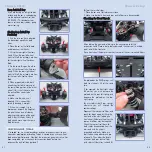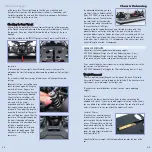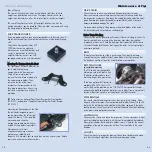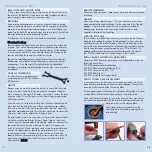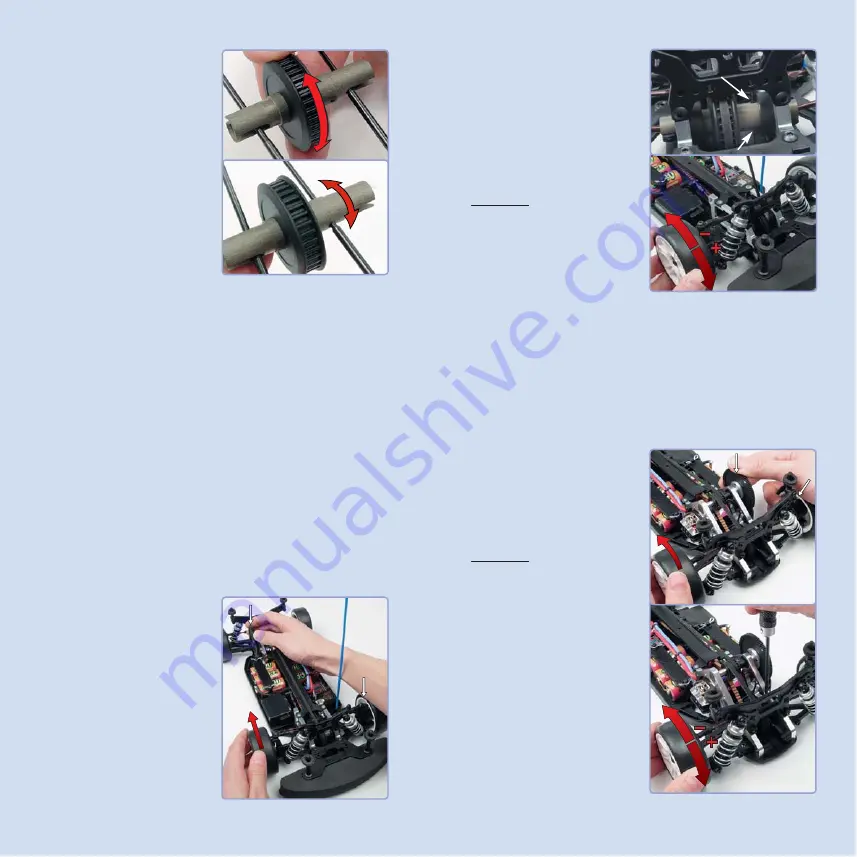
goes all the way through the diff.
••
To ttiigghhtteenn the front diff, rotate the
front right wheel ffoorrw
waarrdd ((+
+)).
••
To lloooosseenn the front diff, rotate the
front right wheel bbaacckkw
waarrdd ((--)).
Tighten or loosen the diff in 1/8 turn
increments, checking the diff
tightness with each adjustment.
Initial Setting:
Diff action is is smooth, but tight
enough so that it takes high effort to
rotate the front right wheel when the
front left wheel and spur gear are
held tight.
A
Ad
djju
ussttiin
ng
g tth
he
e R
Re
ea
arr D
Diiffffe
erre
en
nttiia
all ((iin
n cca
arr))
Place the car on the table with the rear end pointing towards you. To check
rear diff tightness, hold the rear right wheel and the spur gear with your
right hand, and try to rotate the rear left wheel bbaacckkw
waarrdd with your left
hand. If the rear left wheel rotates too easily, you need to tighten the rear
differential.
The diff output shaft on the right side has a hole in it. Place a small hex
wrench into the hole. Rotate the rear left wheel until the wrench goes all the
way through the diff.
••
To ttiigghhtteenn the rear diff, rotate the
rear left wheel bbaacckkw
waarrdd ((+
+)).
••
To lloooosseenn the rear diff, rotate the
rear left wheel ffoorrw
waarrdd ((--)).
Tighten or loosen the diff in 1/8 turn
increments, checking the diff
tightness with each adjustment.
Initial Setting:
Diff action is smooth, but tight
enough so that it takes high effort to
rotate the rear left wheel when the
rear right wheel and the spur gear
are held tight.
Run the car for approximately one
minute, then recheck the diffs
following the steps above.
Hint: The chassis is designed so that
you can very easily adjust the
tightness of the differentials without
disassembling the car. Simply
remove the body, lock up the diff by
inserting a thin Allen wrench through
the aligned holes, and adjust the diff.
C
Chheecckkiinngg tthhee D
Diiffffeerreennttiiaall SSlliippppaaggee
Slide two wrenches into the slots on
both sides of the diff shafts. Hold
both wrenches in one hand and try
to turn the pulley; it should take
some force to get the pulley to slip
between the two outdrives.
C
Chheecckkiinngg tthhee D
Diiffffeerreennttiiaall A
Accttiioonn
Remove the wrenches from the diff
outdrive slots. Hold the pulley
stationary in one hand, and rotate
one of the diff shafts. The other
output shaft should rotate, and the
diff action should feel smooth.
TTiigghhtteenniinngg tthhee D
Diiffffeerreennttiiaall
((oouutt ooff ccaarr))
Insert a small Allen wrench into the aligned holes in the setscrew and long
diff shaft. Turn the long diff shaft 1/16 to 1/8 of a turn clockwise (CW) to
tighten. Remove the Allen wrench and recheck the diff.
LLoooosseenniinngg tthhee D
Diiffffeerreennttiiaall ((oouutt ooff ccaarr))
Insert a small Allen wrench into the aligned holes in the setscrew and long
diff shaft. Turn the long diff shaft 1/16 to 1/8 of a turn counter-clockwise
(CCW) to tighten. Remove the Allen wrench and recheck the diff.
B
Brre
ea
ak
kiin
ng
g IIn
n tth
he
e D
Diiffffe
erre
en
nttiia
allss
Differentials must be broken in properly to operate properly. When
breaking in the diff, the balls create a groove in the diff rings; this is
normal and essential for proper operation. If you tighten the diff fully the
first time you build it, the ball will not create a proper groove, and will
become damaged. When you put the diff in the car and complete the
assembly, run the car for a few minutes, tighten the diff a little bit, and then
recheck the diff. Repeat this process several times until you have the diff
tightened to the point you want it.
Final adjustments should ALWAYS be made with the diff in the car and on the
track.
A
Ad
djju
ussttiin
ng
g tth
he
e F
Frro
on
ntt D
Diiffffe
erre
en
nttiia
all ((iin
n cca
arr))
Place the car on the table with the
front end pointing towards you. To
check front diff tightness, hold the
spur gear with your right hand and
hold the left front wheel against the
table with your right forearm, and
try to rotate the front right wheel
bbaacckkw
waarrdd with your left hand. If the
front right wheel rotates too easily,
you need to tighten the front
differential.
The diff output shaft on the left side of
the car has a hole in it. Place a small
Allen wrench into the hole, and rotate
the front right wheel until the wrench
Final Adjustments
7
8
Final Adjustments
Summary of Contents for T1R Raycer
Page 1: ......

















